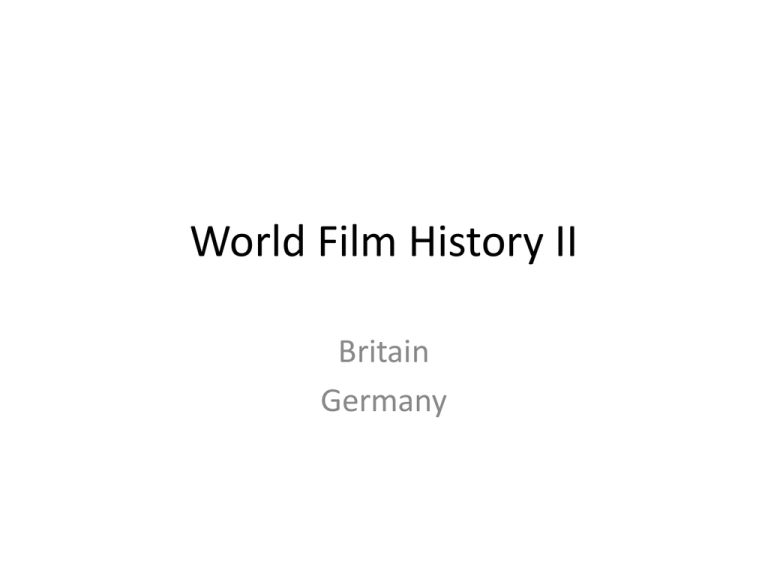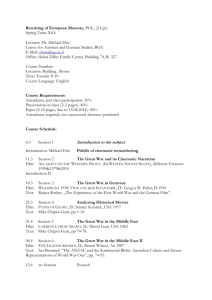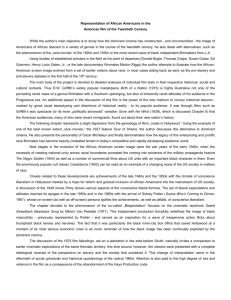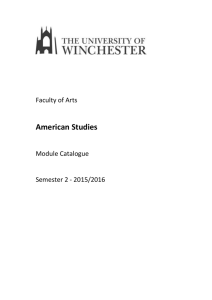World Film History II
advertisement

World Film History II Britain Germany England after the war • The country was significantly impoverished and had lost its empire • Monarchy and class society survived • Restoration of traditional values; fair play and decency • Extolling the nation, its unity, history and traditions: "Small is beautiful, old is good." • 1952 coronation was thought to begin a new ’Elizabethan’ era • Arts Council founded to promote fine arts - exclusively • Arthur Rank’s monopoly thwarted competition but was able to compete with Hollywood in the domestic market England after the war: films • LESLIE ARLISS: The Wicked Lady 1945 • LAURENCE OLIVIER: Henry V (1944), Hamlet (1948) ja Richard III (1955) • DAVID LEAN: Brief Encounter (1945), Great Expectations (1946), Oliver Twist (1947) • ALBERTO CAVALCANTI: They Made Me a Fugitive (1947) • CAROL REED: Odd Man Out (1947), The Third Man (1949), The Man Between (1953) • JOHN and ROY BOULTING: Brighton Rock (1947), The Magic Box (1951), Lucky Jim (1956), I'm All Right, Jack (1959) • LEWIS GILBERT: Emergency Call (1952) • BASIL DEARDEN: The Blue Lamp (1950), The Victim (1961) Ealing-studios • CHARLES CRICHTON: The Lavender Hill Mob (1951) • ALEXANDER MACKENDRICK: Whisky Galore (1949), The Man in the White Suit (1951), The Lady Killers (1955) • HENRY CORNELIUS: Passport to Pimlico (1948) • ROBERT HAMER: Kind Hearts and Coronets (1949), Father Brown (1954) Other popular films • GERALD THOMAS Carry on Sergeant (1958), Carry on Nurse (1959) ... Carry on Doctor (1968) … • RALPH THOMAS Doctor in the House (1954), Doctor at Sea (1955), Doctor at Large (1957) • TERENCE FISHER The Curse of Frankenstein (1956), Dracula (1958) , The Hound of Baskervilles (1959) The Mummy (1959). • VAL GUEST The Quartemass Experiment (1955), Quartemass II – the enemy from space (1957) Cultural pressures • Free cinema movement changed the tradition of documentary filmmaking • Working class theatrical plays • John Osborne’s Look Back in Anger (1956) followed by a wave of works by ’angry young men’ • The breakthrough of the French New wave at Cannes Film Festival • American youth culture New Cinema – stylistic features • Shot in dreary Midlands industrial milieus • Domestic settings and problems, ´Kitchen sink drama’ • Characters genuinely working class, unheroic and deglamorized • Language of the streets • Unknown young actors • Black and white cinematography • Jazzy music New Cinema films and directors • JACK CLAYTON: Room at the Top (1959), Look Back in Anger (1959) • TONY RICHARDSON: The Entertainer (1960), The Loneliness of the Long Distance Runner (1962) • KAREL REISZ: Saturday Night and Sunday Morning (1960) • JOHN SCHLESINGER: A Kind of Loving (1962), Billy Liar (1963) Swinging sixties • Labour returns to power in 1964 after a 13 year period of Conservative administration • It is ’pop’ to be young, working class, fashion conscious, dress colourfully, go to discos … • The spirit of the age is crystallized in the ecstatic reception of the Beatles • In serious filmmaking there is a shift from social issues into depicting internal conflicts • British film industry is flooded by American money and independents face tough competition Majior swinging sixties films • JOHN SCHLESINGER: Darling (1965) • RICHARD LESTER: A Hard Day’s Night (1964), Help (1965) • TONY RICHARDSON: Tom Jones (1963), Charge of the Light Brigade (1968) • LINDSAY ANDERSON: If ... (1968), O Lucky Man! Foreign directors in Britain • JOSEPH LOSEY: The Servant (1963), Accident (1967) • MICHELANGELO ANTONIONI: Blowup (1966) • ROMAN POLANSKI: Repulsion (1965), Cul de sac (1966) • STANLEY KUBRICK: A Clockwork Orange (1971) John Schlesinger: Billy Liar (1963) • Based on a 1959 novel by Keith Waterhouse • Adapted also into a play, musical and a TC sitcom – and inspired a few popular songs • Total Film has ranked it as the 12th in a list of the greatest British Films of all time • Protagonist is a Yorkshire lad who dreams about success and obsessively fools around with women • Schlesinger’s fundamental theme: the need to accept what appears second best because the best is not attainable – or, how to cope between your desires and the real world Cinema in East Germany • Nationalization of the film industry: Deutsche Film Aktiengeschellshaft (DEFA) • Socialist realism, struggle against American imperialism • Production hindered by endless debates about ideological purity; no toleration of ”formalist” experiments • Thaw period only lasted from 1953 to1958 • Back to depicting ”the ideal conditions of the workers and peasants state” and the historical struggle of the working class • Also fantasy, westerns and espionage films • Children’s films sold even to the West Cinema in the West Germany • De-nazification imposed by the Allied forces • Necessity and need to come to terms with the past • Commercialization of the film industry – Freiwillige Selbstkontrolle, but also state control • Dubbing made even American war films palatable • ”Unpolitical humanism”, Heimatfilme • Victim mentality in war and return from the war films • The rehabilitation of the German main – soldiers included • The ideal of the modern, non threatening woman Post-war film in Germany • HANS BURGER: Die Todesmühlen (1945) • WOLFGANG STAUDTE: Die Mörder sind unter uns (1946) • ALFRED WEIDENMANN: Canaris (1954) • HELMUT KÄUTNER: In jenen Tagen (1947), Des Teufels General (1955), Ludwig II (1954) • BERNHARDT WICKI: Die Brücke (1959) The Oberhausen manifesto 1962 • 26 screenwriters and directors sign a manifesto in which they proclaim the death of the old production system and call for a new young German cinema • Severe criticism of popular culture following Adorno and other Frankfurt school thinkers • A social and political rather than aesthetic programme • Earned the subsidies both from the Federal and state governments • Film schools established in Munich and Berlin as well as a film archive in Berlin • Some twenty films made in 1965-68 on this funding • Stylistic features: breaking of diegetic illusion, non-psychological acting, documentary effect Young German Cinema • ALEXANDER KLUGE: Abschield von Gestern (1966), Die Artisten in der Zirkuskuppel: ratlos (1968) • VOLKER SCHLÖNDORF: Der junge Tröless (1966) • JEAN-MARIE STRAUB & DANIELLE HUILLET: Chronik der Anna Magdalena Bach (1968). Germany in the 1970-80s • Subsidies often end up in the production of commercial farce and soft-core pornography • Conflict between terrorism and authoritarian control • Still undigestured past • Feminism, gay movement and counter culture • Filmverlag der Autoren co-operative – Formal beauty and abstraction – Non-explicit argumentation – Sensuality, colours, emotions – to the point of morbidity – Vulnerability of the individual – Heavy symbolism and satirical realism German films in the 70s and 80s • VOLKER SCHLÖNDORF: Der Fangschuss (1976), Die Blechtrommel (1980) • MARGARETHA VON TROTTA: Die verlorene Ehre der Katarina Blum (1975), Die bleierne Zeit (1981), Rosa Luxemburg (1986). • RAINER WERNER FASSIBINDER: Warnung vor einer heiligen Nutte, Der Händler der vier Jahreszeiten (1971), Die Ehe der Maria Braun, Die dritte Generation, In einem Jahre mit 13 Monen (1979), Berliner Alexanderplatz (1980), Lili Marlene, Lola (1981) • WERNER HERZOG Land des Schweigens und der Dunkelheit (1971), Aguirre, der Zorn Gottes (1972), Jeden für sich und Gott gegen alle (1974), Herz aus Glas (1977), Fitzcaraldo (1982) • WIM WENDERS: Die Angst des Tormanns beim Elfmeter (1971) Alice in der Städten (1974), Paris, Texas (1982), Der Himmel über Berlin (1987) • HANS-JÜRGEN SYBERBERG: Ludwig, Requiem für einen jungfraulichen König (1972), Hitler - ein Film aus Deutschland(1977)






